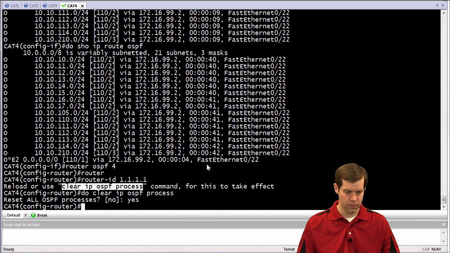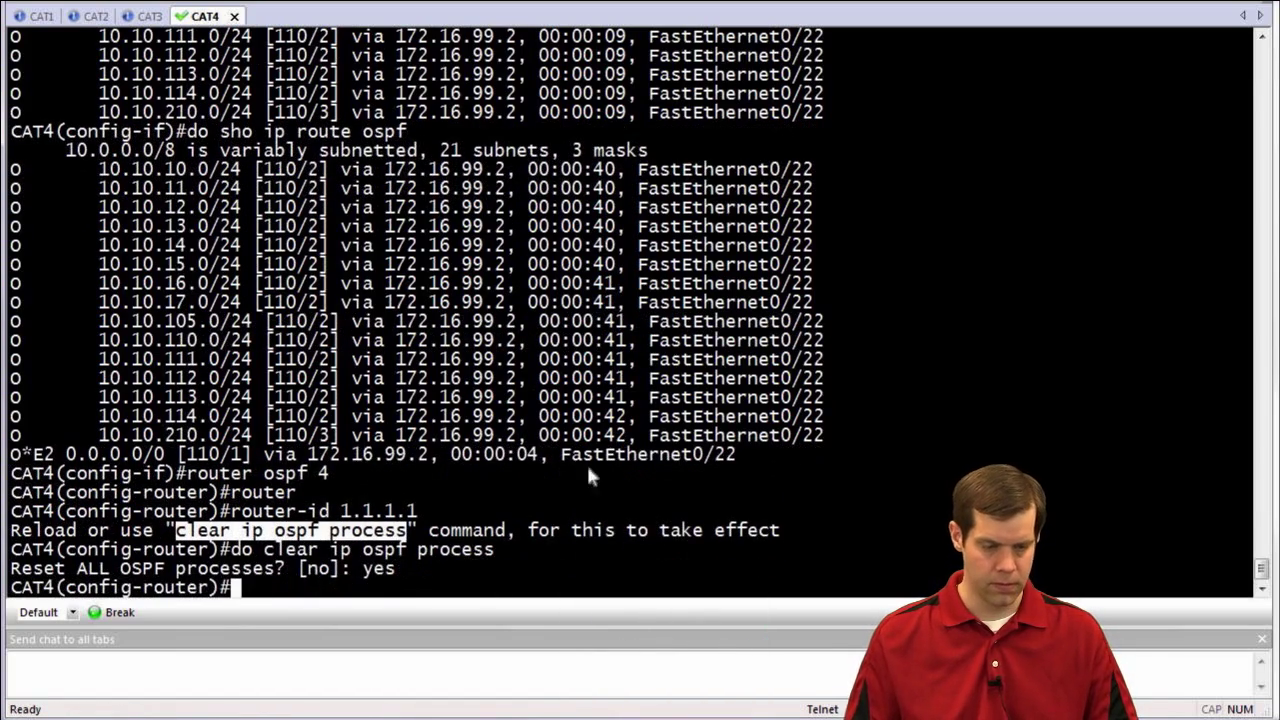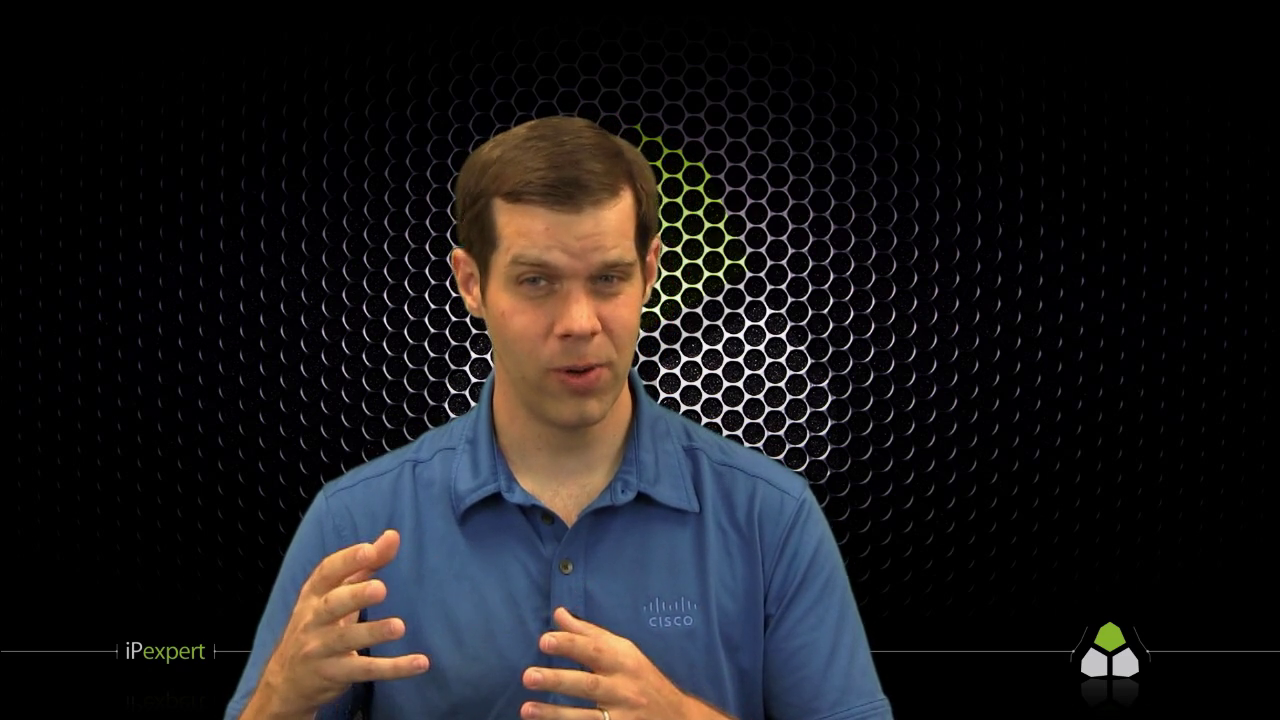iPexpert's Cisco CCIE Wireless Lab Video on Demand
English | 2015 updated | flv | mp4 | H264 1280x720 | ACC 1 ch | 15 hrs 35 min | 3.17 GB
eLearning
English | 2015 updated | flv | mp4 | H264 1280x720 | ACC 1 ch | 15 hrs 35 min | 3.17 GB
eLearning
iPexpert's "Next Generation" Cisco CCIE Wireless Lab VoD Course is designed to provide students with an effective, all-in-one, method of learning the concepts of Cisco's wireless technologies. If you're looking to pass your lab or just become an expert-level Cisco network engineer, this course can help you achieve both!
During this high-definition, studio-recorded video course, you'll instantly be engaged as you watch Jeff Rensink, one of the industry's most respected CCIE wireless instructors, explain the theory, conduct white boarding and configure countless advanced, technology-focused lab scenarios on nearly every protocol or technology that you'll encounter on the actual CCIE Wireless lab exam.
As you begin your CCIE lab preparation, it's important to understand the protocols and technologies listed in the CCIE blueprint in mastery detail. iPexpert's CCIE Wireless Lab Video Course was designed to do that. The quality and amount of content covered, as well as the quality of the delivery and presentation of this one-of-a-kind video class, makes for a training resource that's unmatched within the Cisco training industry.
Also, it's our commitment to ensure that content is added and updated on a regular basis. All updates and additions are instantly made available to you at no additional cost.
Wired Infrastructure Section Overview
- VLANs
- Access Ports
- - Access VLANs
- - Voice VLANs
- Trunk Ports
- - Encapsulation methods
- - Native VLANs
- - Allowed VLANs
- DTP
- VTP
- - Modes
- - Domains
- - Versions
- - Passwords
- - Pruning
- EtherChannels
- - Negotiation protocols
- - Load balancing
- - WLC best practices
- Spanning Tree
- - Root election
- - Topology control
- - Optional features
- - - Portfast
- - - BPDU Guard
- - - BPDU Filter
- Layer 2 Security
- - MAC filtering
- - Port Security
- Power Over Ethernet
- IP Addressing
- - IPv4
- - IPv6
- - Physical interfaces
- - Switched Virtual Interfaces (SVIs)
- HSRP
- - Basic operation
- - Preemption
- - Timers
- - Authentication
- Static Routing
- - IPv4
- - IPv6
- - Default routes
- EIGRP
- - Basic configuration
- - Passive interfaces
- - Adding a default route
- - Router-IDs
- - Advanced features
- OSPF
- - Basic configuration
- - Passive interfaces
- - Adding a default route
- - Router-IDs
- - Advanced features
- Multicast Routing
- - PIM dense mode
- - PIM sparse mode
- - RP assignments
- - - Static assignments
- - - Auto-RP
- - - BSR
- - Anycast RP with MSDP
- - IGMP
- Wired QoS
- - Classification and marking
- - Trusting markings
- - QoS maps
- - Policy maps
- - Matching voice traffic
- Switch Services
- - NTP
- - DHCP
- - Telnet/SSH
- - SNMP
- - Logging
ACS Section Overview
- Server CLI
- - Time
- - NTP
- - IP addressing
- - Working with the ACS service
- - Password recovery
- - DNS
- System Administration
- - Management users
- - Password settings
- - Protocol settings
- - Server certificates
- - Repositories
- - Backups
- Network Resources
- - Adding devices
- - Network device groups
- - Default network device
- Users and Identity Stores
- - Local user groups
- - Internal user repository
- - - Creating users
- - Internal host repository
- - - Creating host entries
- - LDAP servers
- - Active Directory
- - - Joining to a domain
- - - Specifying AD groups
- - - Using additional attributes
- - Certificate Authorities
- - CA profiles
- - - Integrating LDAP and AD
- - Identity Store Sequences
- Policy Elements
- - Date/time matching
- - Creating custom conditions
- - End station filters
- - - Matching on SSIDs
- - Device filters
- - Creating authorization profiles
- - - Accomplishing VLAN overrides
- - - Applying ACLs
- - - Setting session timeouts
- - Creating Shell profiles
- - - Tips for better results
- - Command sets
- Access Policies
- - Creating new access services
- - Working with service selection rules
- - Specifying allowed protocols
- - Controlling the use of Identity stores
- - - Using single result selection
- - - Using rule based result selections
- - Authorization rules
- - - Customizing matching criteria
- - - Using the default rule
- - - Tips for how to write authorization rules for best results
- Monitoring
- - Viewing authentication logs
- - Configuring alarms
- - - Emailing alarms
- - - Syslogs
Autonomous APs Section Overview
- Interfaces/VLANs/Bridge groups
- - Configuring the management interface
- - Setting a default gateway
- - Adding sub-interfaces
- - Configuring VLANs
- - Configuring Bridge groups
- - Validating the interface/VLAN/bridge group relationship
- Client WLANs
- - Open SSIDs
- - Static WEP SSIDs
- - WPA PSK SSIDs
- - Dynamic WEP SSIDs
- - WPA 802.1x SSIDs
- - Broadcasting SSIDs in beacons
- - RADIUS authentications
- - - Using ACS
- - - Using local RADIUS on the AP
- WDS
- - Enabling on APs
- - Authenticating APs to the WDS
- - Controlling client authentications through WDS
- Root/Non-Root Bridges
- - Enabling the feature
- - Controlling VLANs
- - Handling spanning-tree issues
- Repeater APs
- - Enabling the feature
- - Root AP configurations to support the repeater
- Workgroup Bridges
- - Enabling the feature
- - Controlling VLANs
- - Handling spanning-tree issues
- - Roaming enhancements
- - Preserving client advertisements
- Universal Workgroup Bridges
- - Enabling the feature
- - MAC address options and behavior
- Misc configurations
– Physical interface configurations
- - Data rates
- - Power levels
- - Channels
- - Peer-to-peer blocking
- - Packet retries
- - Antenna configs
- Administrative access
- - Local users
- - Granting management access via TACACS
- - Granting management access via RADIUS
- AP authentication
- - Using credential sets
- - Using EAP profiles
- Client filtering
- - Using the global association list
- - Using MAC filtering on SSIDs
- - Using ACLs to filter clients and traffic
- - How filtering affects clients
- - - Normal clients
- - - AP associations
- - - Clients behind WGBs and Repeaters
- Services
- - Telnet/SSH
- - HTTP/HTTPs
- - CDP
- - SNMP
Unified Wireless Networks Section Overview
- Ports and Interfaces
- - Enabling/disabling ports
- - Interface types
- - - Management
- - - AP managers
- - - Virtual
- - - Dynamic
- - - Service Ports
- - - Interface groups
- - Configuring interfaces
- - Troubleshooting connectivity
- Management Access
- - Local management users
- - Granting management access via TACACS
- - Granting management access via RADIUS
- - SNMP/WCS management
- Services
- - Time
- - NTP
- - DHCP
- - - Proxy mode
- - - Option 82
- - - Internal DHCP server
- AP discovery process
- - Layer 3 broadcast discovery
- - DHCP option 43
- - DHCP option 60
- - DNS discovery
- - Static primary/secondary/tertiary discovery
- - Previously remembered WLCs
- - Troubleshooting the discovery process
- AP join process
- - Join process overview
- - Controlling the join priority
- - - Primary/secondary/tertiary configs
- - - Master controller mode
- - - Tie breaker
- - Troubleshooting the join process
- AP High Availability
- - Learning about failover options
- - - Mobility group membership
- - - Primary/secondary/tertiary
- - - Backup primary/secondary
- - Heartbeats and timers
- - Verifying failover
- General Config- Security/Management/Commands
- - SNMP
- - - Local SNMP
- - - SNMP trap control
- - - Specifying SNMP trap receivers
- - Login banners
- - HTTP/HTTPS
- - Telnet/SSH
- - Logging
- - - On the WLCs
- - - On the lightweight APs
- - Management via Wireless
- - Working with RADIUS and TACACS servers
- - Local users
- - Local MAC filtering list
- - Controlling AP policies
- - Local RADIUS on the WLC
- - Working with ACLs on the WLCs
- - - Configuring client ACLs
- - - Configuring CPU ACLs
- - - Method for applying ACLs
- - Working with rogue APs
- - - Rogue discovery
- - - Rogue classification
- - - Auto-contain
- - Working with IDS signatures
- - - Preinstalled signatures
- - - Custom signatures
- - Enabling MFP
I- - - nfrastructure MFP
- - - Client MFP
- - Web authentication options
- - - Local stock page
- - - Custom pages
- - - External authentication servers
- General Config- Wireless
- - AP global configurations
- - - Global credentials
- - - AP wired 802.1x
- - - Failover priority
- - Individual AP configurations
- - - General configs
- - - Radio configs
- - - Overriding global defaults
- - Client load balancing
- - Client Band Select
- - Radio settings
- - - Data rates
- - - DTPC
- - - ClientLink
- - RRM configs
- - - RF grouping and leaders
- - - TPC
- - - DCA
- - - Coverage hole detection
- - - Off channel scanning and monitoring
- - CCX roaming enhancements
- - 802.11n
- - CleanAir
- - Country codes and regulatory domains
- General Config- Controller
- - General controller configs
- - Multicast
- - - Enabling client multicast
- - - AP multicast mode
- - Mobility domains
- - - Working with mobility group membership
- - - Anchor settings
- - - Mobility multicast messaging
- - CDP on the WLC
- WLAN configurations
- - Radio policies
- - Multicast VLAN
- - Layer 2 security options
- - Layer 3 security options
- - Working with AAA services
- - QoS settings
- - Advanced settings
- Wireless Guest Networks
- - Single vs dual WLC designs
- - Configuring guest tunneling
- - Configuring foreign maps
- - The guest authentication progressing
- - Troubleshooting guest WLANs
- Other LANs
- - Wired Guest networks
- - - Single vs dual WLC designs
- - - Guest LAN interfaces
- - Remote LANs
- AP Groups
- - The default group
- - Configuring new groups
- - Controlling WLAN to group mappings
- - Using AP groups across multiple WLCs
- AP modes- Misc
- - Local mode with wIPS
- - Sniffer Mode
- - Rogue Detector mode
- - SE Connect mode
- - Monitor mode
- - - Tracking optimized monitor mode
- - - Monitor mode with wIPS
- AP modes- H-REAP
- - Overview of H-REAP WLAN states
- - Local switching
- - Local authentication- external RADIUS
- - Local authentication- internal RADIUS
- - H-REAP groups
- - H-REAP failover progression
- AP modes- Office Extend
- - Personal SSID
- AP modes- Mesh
- - General mesh deployments
- - Mesh AP authentications
- - Wired bridging
WCS/MSE Section Overview
- WCS Administration
- - Working with the WCS service
- - Password recovery
- - Management authentication
- - - Local users
- - - RAIDUS authentication
- - - TACACS authentication
- - User preferences
- - General server settings
- - Background tasks
- - Logging
- - Virtual domains
- - Working with the dashboards
- Managing devices in WCS
- - Wireless controllers
- - - Adding controllers
- - - Configuring controllers directly
- - - Configuring controllers via templates
- - - Configuration groups
- - - Config auditing
- - Lightweight APs
- - - Adding APs
- - - Configuring controllers directly
- - - Configuring controllers via templates
- - Autonomous APs
- - - Adding APs
- - - Configuring controllers via templates
- - - Autonomous to lightweight migrations
- - Adding switches
- WCS Reports and alarms
- - Configuring reports
- - Scheduling reports
- - Viewing reports
- - Controlling report save locations
- - Working with alarms and events
- - Enabling Alarm emails
- - Tweaking alarm severities
- WCS Maps
- - Map hierarchies
- - Adding a campus
- - Adding a building
- - Adding a floor
- - Adding an outdoor areas
- - Editing maps with obstacles and areas
- - Adding APs to maps
- - Controlling what is viewed on the maps
- MSE
- - Working with the MSE service in the CLI
- - Running the MSE setup script
- - Adding an MSE to the WCS
- - Enabling MSE services
- - Synchronizing items to the MSE services
- - NMSP verification and troubleshooting
- - Configuring location tracking
- - - Defining with to track
- - - Setting limits on device categories
- - - Filtering items
- - - Tracking history
- - - Advanced tracking configurations
- - - Getting items to appear on the maps
- - Configuring context aware notifications
- - Working with wIPS
- - - General wIPS configurations
- - - Creating and editing wIPS templates
- - - Applying templates to WLCs
Voice/Video Section Overview
- 7925 phone overview
- - Radio features
- - Data rates
- - Security features
- - Power savings
- Voice WLAN config
- - Best practices for voice WLAN configurations
- - Voice auditing tool in WCS
- - Option WLAN configs for voice
- Global voice configs
- - Radio configurations for voice
- - CAC
- - - CAC for WMM devices
- - - CAC for SIP phones
- - - CAC for 7920 phones
- -EDCA profiles
- -QoS profiles
- 7925 configurations
- - Configuring WLANs
- - Call manager discovery process
- - EAP timers
- Wireless QoS Markings
- -WMM UP markings
- - Overview of how WLCs and local mode APs mark traffic on the wired network
- - Overview of how H-REAP APs mark traffic on the wired network
- - Overview of how Autonomous APs mark traffic on the wired network
- - Recommendations on which markings to trust
- Voice/Video on Autonomous APs
- - Configuring general QoS
- - Configuring access categories
- - Enabling CAC
- - Configuring policy maps
- - Defining low latency queues
- - Defining low latency data rates
- - ARP caching
- Video on Unified wireless
- - General video WLAN recommendations
- - General video CAC configurations
- - EDCA profiles for video
- - Configuring VideoStream
- - - Enabling globally
- - - Defining streams
- - - adio configurations
- - - WLAN configurations
- - - Multicast requirements
Lab Preparation and Strategy
- Preparation
- - Available study tools
- - Learning individual technologies
- - Learning technology interactions
- - Using practice labs
- Test taking strategies
- - Lab day expectations
- - Lab details
- - Lab PC interface
- - Tips for the days leading up to the lab
- - Tips for the lab itself
- - Recommended order of operations
- - Section tracking
- - Using the proctor
- - What to do after the lab
- - Tips on increasing your speed
Screenshots:











